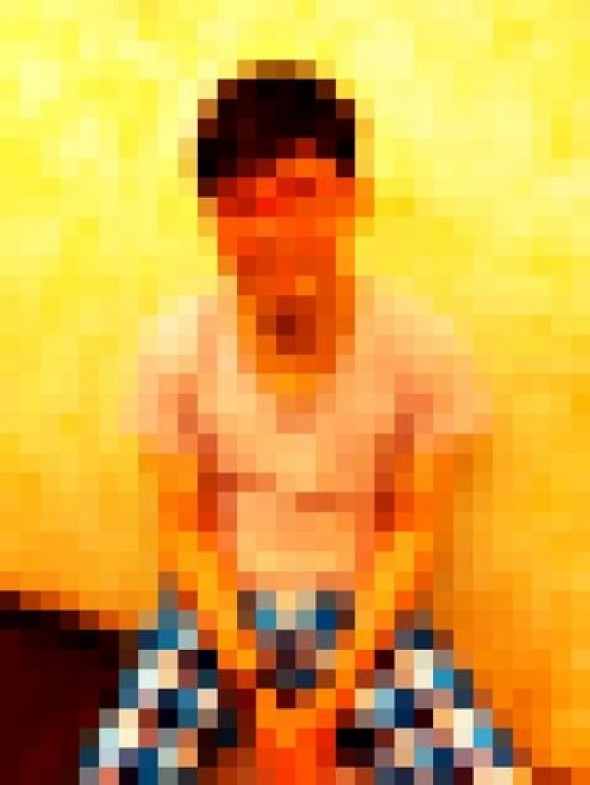We Hate the Users: An Interview with UBERMORGEN
Several decades after the birth of artivism and net art, UBERMORGEN continue to make art with and about networked society. But where net art 1.0 was largely critical of capitalism’s use of networks, today UBERMORGEN’s tactics work through an aesthetics of affirmation. Interview by Stevphen Shukaitis
UBERMORGEN are nothing if not a little contrarian. Operating mainly as a digital and net art project since forming in 1995, their work cuts stridently against two quite prominent clichés in the way digital media and art are discussed. Firstly, the celebration of the utopian potentials of digital media and technology and, secondly, the way in which participatory dynamics in artistic practice apparently form the basis of political engagement. And these two tendencies seemingly converged in the democratising potential of net art that was going to liberate us all....
UBERMORGEN however have continuously focused their work on exploring the dark sides of technology and the net. While this may have seemed a bit strange in the various cycles of new economy fuelled tech-fetishizing, today it makes all too much sense. The approach has varied across their many projects, but tends to focus on exploring the formal properties of technologies and systems, as well as the more antagonistic elements found within them. I took the opportunity to go and interview them this autumn, while they were installing their first UK exhibition at the Carroll / Fletcher Gallery in central London.
Stevphen Shukaitis: One thing that strikes me is how one could see how your work over the past ten to 15 years has focused on the dystopian, dismal side of technology – the workings of technology and its power, in a Ballardian sense. But it seems that over the last few years the dark side of the net, rather than something that needs to be revealed or drawn out, has become really obvious. If that is the case how does that change your work and approach?
UBERMORGEN: Indeed, many things have changed. They always do, but after 9/11 you could still ignore legal situations that had been put in place, at first. But over time, from around 2005, the so-called terror measures from the US started creeping into European legislation, such that you couldn’t just work any more as you did before. We just didn’t care about the legality of it all, it always used to be okay. But when you’re suddenly confronted with all these anti-terror laws, it’s not just the laws themselves that govern your work, but the implication that these laws really have.
Because we’re not just talking about getting sued – that you might have to stand in court or whatever – but that they don’t need any courts to apply their terror laws. Terror laws operate without courts, and that’s a huge leap. With most of our projects it’s never the question ‘why should we do it?’ it’s mostly a question of ‘why shouldn’t we do it?’ – because it’s interesting, let’s just go for it. But when you’re confronted with the possibility of getting into serious legal trouble, then it’s not fun any more. It just really spoils the party.
SS: Indeed. One could think here of how this impacted someone like Steve Kurtz from the Critical Art Ensemble. How would you say this has affected your work?
U: Take a project like Vote-Auction, now you couldn’t do it. Or you could, but we’d have to set up a whole different technical and personal scenario in order for the project to work – but then it wouldn’t be the same project any more. Because with a venture like Vote-Auction, it works by using the impetus of the moment. You’re not trying so much. You do have a plan in the back of your mind, and you can always outsmart possible opponents, but it’s not laid out clearly. And that’s why you would have to do it in secret, to protect everything about yourself, and have everything done anonymously. That is a different question and so you can’t work the way we did in the beginning of the 2000s. That’s just not possible any more.
SS: How does that dynamic feed into your current work and this exhibition? I’m thinking in particular here of pieces like Do You Think That’s Funny? Would you rather have something publicly displayed – even though in that display you have something that can’t be seen being transmitted, going back and forth between two cables, some information that you know is there, but you can never know what it is.
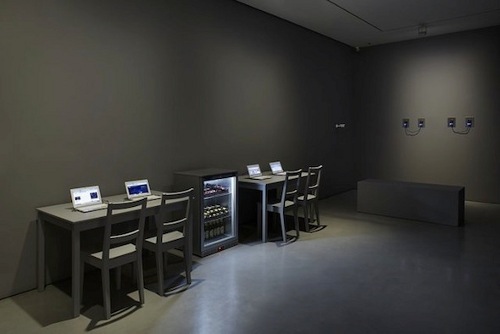
Image: UBERMORGEN, Do You Think That’s Funny?, 2013. 4 Beagle Bones, Snowden Files (encrypted), Glass front Fridge, Club Mate, 4 Tables, 4 Chairs, 4 Netbooks, Ethernet Cables, Amnesia OS, Manuals, 1 Split-Screen, 4 CCTV Cameras, 4 USB Flash Drives. Courtesy Carroll/Fletcher
U: That’s all pretty much always the case, right? Obviously we understand that for a large public these revelations, whether by Manning or Snowden or whoever, may be news – but of course they’re not news to us and they’re not news to lots of other people. They’re not news to anyone who has any knowledge about technical aspects of the internet, plus some psychological intelligence. It always tells you anything that can be done, will be done; so this is not news. But how do you visualise something that’s now illegal to visualise, even though it exists out there in the world? Everyone knows it. Whole societies depend upon this shit, you know, but don’t show it. And so that’s why we have to do projects in secret. That’s why we started kind of doing our secret project where we installed Amnesia machines at home.
We did a few test runs of secret projects. We showcased them once in Amsterdam. It was kind of bizarre because we were actually planning a complete project but knowing if we do what we want to do, we can’t do it as UBERMORGEN. That’s when we said ‘Okay, let’s do a secret project.’ And then the idea was to install the machines and the whole set-up… but not showcase the content, just the formality of it. That’s what we’ve come up with here, where it’s all very formal if you look at it, because you just have the machines and just the hardware. The data is there. In Amsterdam we didn’t have any data. Here we do have data, but it’s not accessible.
SS: Is that an overall shift in your practice where the focus is not so much showing what’s happening, but rather what gets hidden?
U: Yes, you can go into hiding once in a while, it’s fine, but as a mindset it’s stupid. If you go into hiding, you’re just defining yourself as a loser. Of course sometimes it makes sense. But we always like using affirmative approaches. When you say ‘it’s secret, this is all very secret so let’s keep it that way,’ that means that you can’t show any work any more. Then that’s the way it is because that’s what society wants. So let’s totally embrace that. Yes, sometimes it’s even less work for us. The only downside to it is basically a market problem because for certain projects we cannot attach to our brand any more, so it’s kind of anonymous. But this very much plays into the current situation. It’s not a coincidence that Anonymous became so important because that’s the logic of the moment. It’s the logical conclusions from 9/11 up until now, that basically you are only able to operate in an anonymous capacity if you want to do what you want to do: if you want to enjoy and live the freedom you are entitled to as a human being.
SS: That’s an interesting way to frame it. Previously I had thought there were two main strategies in your project. One would be to find ways to intervene in particular assemblages of technology, power and social relationships. To ask ‘What are our options? What could we do with this arrangement?’ The last time we talked I was struck by the emphasis on coming into a situation without a preconceived notion of what you want to accomplish, to conduct research into them by transforming them, but without a preconceived goal in mind. This is quite different from the vast majority of ‘political art’ or ‘activist art practice.’ And then the second strategy is taking things that are already happening, already in motion, and seeing what you can make out of them. And that’s something more evident in projects like the oil painting and Deephorizon project , where you declared that oil spill to be the world’s largest oil painting. It’s not that you’re actually necessarily doing something yourself. You’re taking what’s already there and asking, ‘well, what is this?’ How can we aestheticise this or understand it in a different way?’ Based on our conversation here it sounds like there’ a third approach where the focus is more about creating formal spaces for the exploration of what can’t be said. And yet it seems impossible for that space to exist, why is that?
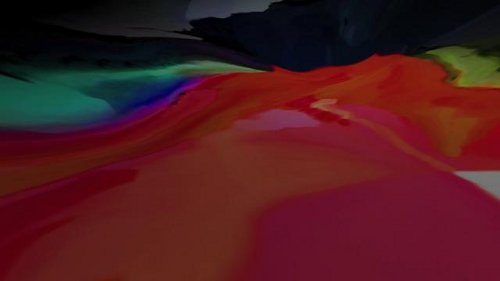
Image: UBERMORGEN, still from Deephorizon, 2013
U: That’s right. We did a workshop in Damascus a few years ago. There were a few people who had project ideas that were rather critical of the Powers That Be at the time, but they said ‘well, we can’t publish it this way.’ So we suggested they try to go the other way: don’t criticise, just find holes where you can dig into it. You’ve got to be affirmative, but just pick something that doesn’t make any sense in the society but is, you know, positively sanctioned by the government and then overemphasise it. And there was one project that did this, it had to do with Assad being an eye doctor and just talking about this incredible aptitude for seeing things. We just started talking about it and it was clear that they can do something with this because he’s an eye doctor, he knows what he sees, and that way you can talk about stuff you’re not supposed to talk about.
And this works really well with any kind of repressive authority, because you’re not criticising it. And sometimes it just really doesn’t make sense to criticise authorities, because if an authority is set up like the ones in the US or the UK, they have ultimate powers, and all that criticism will get you is prison in the end. You already know up front that you’re going to lose, unless you set up a revolution. Unless you want to prove the point that ‘I’m doing this and already going to prison for it,’ it doesn’t make sense.
SS: That does seem tactically nonsensical...
U: In Singapore we’re seeing the same thing. You know, whether authority or government or dictatorship, they always have a few big advantages to them, right? Safety, for example. Criminality tends to reduce a lot…
SS: Or the continued existence and construction of public housing.
U: Yes, that’s clearly very positive. But then the question becomes which dictatorship do you prefer? The dictatorship in Syria or the democracy in Kenya? The situation we’re in right now, we have these very authoritarian laws in place. If any country has laws that allow the state to put you in prison without any courts, then it’s a dictatorship by definition in the end. You can still vote, but we all know what that has become. It’s all freakin’ mayhem. We’re all occupied in our consumerism and freedom of consumption. That’s awesome, isn’t it? At the moment it’s really important to look at what can be done and what can’t be done and, as you point rightly out, it’s also important to look at what cannot be done. Yes, it’s not as flamboyant but, we think it’s important.
SS: One thing that I wanted to ask you about is previously UBERMORGEN has been described as a kind of digital Viennese Actionism. Could you talk a bit a about that and how Actionism influences your work?
U: The first time we had this connection was around the time after the Vote-Auction project, because we suddenly felt that it’s all about the body. It’s just the body that is the medium in the end, even if it’s a completely mass media digital project. Because in the end all the energy, all the informational data, all the pressure, all the fear, the aggression, everything is going through your body and you’re like a membrane. So all the things we do, as we see it, have this consistency, even if it doesn’t look that way. It’s socialisation and artistic socialisation. This aspect is always part of the work.
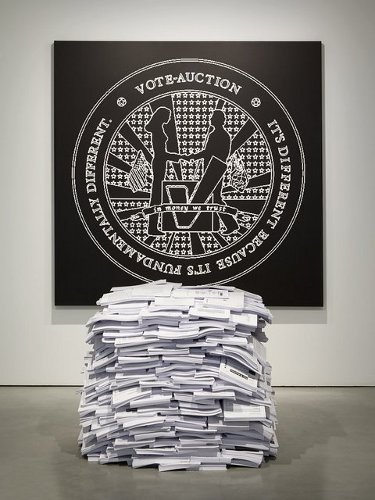
Image: UBERMORGEN, [V]ote-Auction Seal, 2000. Pigment Print on Fabric, 200 x 200 cm; [V]ote-Auction 700Kg, 2005. A4 Paper, 92 x 108 x 95 cm, installed at Carroll / Fletcher Gallery, 2013. Courtesy Carroll/Fletcher
SS: That’s quite interesting in the sense of highlighting how digital, rather then being dematerialised, is actually about material effects on the body: how media affects you, how everything comes back to, yes, back to the body ultimately, right?
Ubermorgen: Yes, it’s physical. It’s a very physical role. Even if the networks have become part of our reality, the networks are very physical. We’ve always been majorly fascinated by cables. Complete cable fetishism, deep-sea cable fetishism. That first infected us through Neil Stephenson’s 1996 article in Wired Magazine. It’s a 30 or 40 page essay about his two or three month journey travelling along cable building sites and with ships laying cable in the oceans. And if you understand this and then if you’re close to the hardware – that’s why we also like to work here with hardware and we want to show the routers and we want to show the iPhone sized servers and shit like that. It is physical, it is about hardware. That’s also where there is this link, because in the end the Actionists were also kind of stating that in the end it’s all about excrement and sex and body and violence and love; that it comes down to the basics. And you can go anywhere you want; you can go to space, you can go into the cable, into what we did with etoy in the ’90s, complete digital emigration. You use drugs along with it and lose your body, but your body fucks up. You end up in a psychiatric hospital to get better, you end up as a chemical cyborg.
SS: Exactly. And in a weird way that’s kind of the point. Or at least that’s the argument that Bifo has been making for the past few years: that the entire net economy and its multiple bubbles were held together by this illusion of unlimited productivity largely fuelled by various chemical substances. And thus the economic crash can be understood as a kind of exhaustion which occurs when the body is depleted, and with it the hyper-productivity that was providing the illusion of unlimited growth. There’s only so far it can go before it collapses, and quite spectacularly.
Ubermorgen: We like the idea of exhaustion, although we haven’t come across Bifo’s texts on this, or this idea, but actually exhaustion is something we have worked on. There’s a quote in the u s e r u n f r i e n d l y publication, for the exhibtion, in an interview with Tobias Noebauer – he’s an Austrian physicist. And I used the quote by this Austrian researcher who says that basically what’s going on now, this massive surveillance by entities like NSA and other such organizations has led to its own impossibility and in consequence the total exhaustion of the surveillance apparatus.
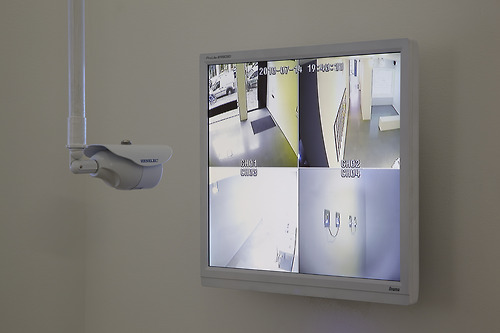
Image: UBERMORGEN, CCTV, A Parallel Universe, 2013, Carroll / Fletcher Gallery
SS: On another topic, how did you start doing the sort of pixel painting images, because it seems a very strange process to have hand painted versions of heavily pixelated images?
Ubermorgen: The shopping cart images were first; they are basically the original pixel paintings or grid paintings because it’s the original resolution. So what you do is you just blow it up and you make a pixel. You have to do the right pixel repetition, then you can blow it up and then it’ll be exactly the same thing, just in large, and that’s it. We were doing live grid painting while 9/11 happened, we took thumbnail sized images from online news sources. We used thumbnails because that’s kind of the information distance we are at. So you’ve got 60 by 40 pixels and that’s about the information you get. So in the 256 websafe colours that’s all. What you see is what you get. And, if you want to put it this way, it’s a very nice comment on mass media and the information depth we get out of these channels.
It’s the same thing we’ve done here with Singapore Pyschos. It offers you something like what a therapist offers when he gives himself as a blank projection screen to be reflected on. Something like that, with a title like Singapore Psychos, or then with the 9/11, it offers you a chance to fill in the empty blank spaces. And another interesting thing is that if you do that on the image, you see much more. The brain creates an image that is not actually there. We as human beings can’t process every molecule in the universe, but our brain has the capacity to close gaps, essentialise and then individually complete fractional information… it seems as if our senses, our interface… have a very limited resolution but we seem to be able to work around this limitation.
SS: By leaving more out of the image you actually demand more of the viewer?
Ubermorgen: Well, we’re not talking about reality versus virtual reality, but mediality. What we refer to as reality very often is just mediality, and also because that’s how human nature often prefers to observe reality, you know, via some media. And it happened during 9/11: we very often heard that people watched TV in order to confirm reality. It’s not really surprising, but it makes itself clear. It’s still interesting to see how mediality is stronger than reality. But what we get via the media is usually just really small thumbnails. We perceive our society as thumbnails. In real life you zoom into something and you get more detailed information. In a media-driven world you zoom into something and all you see is that there’s nothing there; then your brain and imagination kick in and start to do weird things…
SS: Using heavily pixelated images seems to be a sort of general aesthetic strategy across multiple projects. But it’s clear from the way you’re framing it here that it’s much more then just an aesthetic approach, it’s a kind of political claim, or a structuring of a claim of the political.
Ubermorgen: Yes, it’s part of what we’re setting up right now on the floor below. There’s this partially printed canvas of bare chested Putin fishing, which will be outshone by the projection of an Animated GIF onto the canvas. But he gets taken out of the image, and then the background is re-constructed. Putin dissolves into the forest. And even though it doesn’t matter if this pixel is not as dark a shade as the other one… because it’s a forest, it doesn’t change anything. But on the other hand, it doesn’t exist. It just looks totally fine and you couldn’t tell that it’s fake because it’s such a low resolution. You can only tell something has been faked if it’s high resolution. In one sense it doesn’t make a difference if the trees now grow this way and not that way. But with lots of other things it makes a huge difference.
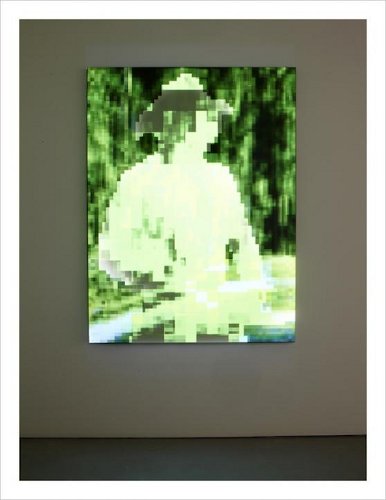
Image: UBERMORGEN, Vladimir, 2013. Image courtesy of Caroll/Fletcher
SS: But that’s a different approach to, for instance, doing a project where you say ‘we’re being blinded’ or there’s very little information. You seem to be just sort of working and engaging with that low information level on its own terms, rather than critiquing it.
U: Yes, absolutely. That’s why we use them. At the beginning, you referred to the non-agenda or the non-intentional strategies of the way we work, yes, so that’s one part of it, the affirmation of existing systems and technologies. We’d rather embrace them because there is a lot of beauty in them. And then you can use the technique of over affirmation if you want to make a point, but we don’t have to make a point. We don’t want to make a point.
We don’t want to make a point because there isn’t one point. You cannot fix things down to something that you can visualise, things that you like or that you find interesting. That is something we consider our responsibility – freely sharingfree all our findings. That’s the only thing. Openness is our only responsibility, so that’s what we do.
SS: On the way here I was talking with a friend about some of your previous projects and about them not having any particular politics attached to them. My friend was quite befuddled by this, as she seemed to think there was quite clear political meanings and intentions in them. For instance that Vote-Auction was really about democracy. But this makes me wonder, if your intent is specifically to keep open a space by not having to be fixed by intentions. How do you stake out that space? How can your work keep open that space without having to commit yourself to some notion of politics, even if it’s just the politics that justifies that space itself?
U: It’s a fundamental misunderstanding. But having said that, the intention of the producer of a work and the reception, the user, are two completely different things. They have nothing to do with it and we don’t want them to have anything to do with each other because we don’t want to know. We hate the users. And we love the users! But we don’t want to know. They can do whatever they want with this. That’s our philosophy. It’s like information, the moment you release it – and this applies for our work, as well as for an interview – the moment you release it into the wild, mass media, online, whatever, it’ll be used. It’ll be used by people, by journalists for their own agenda, by people who’ll manipulate it etc., and that’s good. We can’t control it any more. So we’re only the producers and our intentions are ours. They’re private. You don’t have to know. We don’t want you to know. Every lecture we start off with saying ‘this is not political art’. We are not activists; we’re actionists. Yes, we work with our bodies, we work with certain contents, but we’re not politically motivated. There is no goal.
SS: But even staking that out as a claim is something, in the context of the past ten to 15 years and the widespread religion of participatory art as offering salvation. The argument you’re making here is not just about not having intentions, it resists the conflation of ethics, aesthetics and participation in an almost militantly non-intentional direction, militantly non-participatory.
U: We don’t care. We’re opportunists, and don’t give a fuck. We have our personal, private, political or social views, but they don’t have anything to do with our art on this level. Why do you think a work that we produce together has one political vector and wants to make a point? For Vote-Auction we were pretty much in favour of what we actually didn’t do, which is selling and buying votes, because it was obviously on one level that’s what’s already happening anyway… it was only afterwards that we opened up and reported that it was a complete fake. We didn’t during the action. Instead it stayed 100 percent straight and we posed as Eastern European business people. And nobody in the art world understood that this was an artwork. Everybody thought that this is just some weird business people doing weird shit.
Honestly, of all the media for that action, CNN was the most professional and that maybe shows you how fucked up the mass media world is. CNN was the most professional media partner we had. They were really trying to find out if this was a kind of fake or not. 99.9 percent of other journalists from Le Monde and Frankfurter Allgemeine and New York Times, Washington Post didn’t even bother to research. They just copy pasted. They just bought it, which is unbelievable. We lost faith in mass media. Their lack of willingness to carry out the very basic level of fact checking. And that applies to other government agencies, like the FBI, who at that point in 2000 still did not seem to grasp the very basic facts of how the DNS system worked.
SS: Strangely enough I find the concept of an evil system run by idiots who don’t know what they’re doing even more terrifying. I actually find this really horrifying. If there’s a cabal of menacing people running things, well, as long as they have some clue of what they’re doing it seems less worrying then if they really have no clue. That’s genuinely terrifying.
U: We don’t find it terrifying because there’s a few things that really work, like aviation. They know what they’re doing. But politicians and the system and, you know, the engineers all in between it, they’re fucking idiots. Most of them don’t have the technical knowledge. They’re designing stuff they don’t understand at all. It’s ridiculous. But on the other hand, the world has always existed even though there’s that many idiots around. Nature can deal with it apparently. But, but on the other hand look at Fukushima; a disaster happened just because you build a nuclear plant on a fault line, which tends to create earthquakes that lead to tsunamis. That was just bound to happen. Why were they that stupid? And the answer is, because it is that stupid. We’re human beings. We’re not smart in a group. We’re stupid in a group. But it has not killed all of us so far.
SS: I guess that just creates like pockets of openness within the various social and technical assemblages.
U: There was one interview we did from Vote-Auction that was with a five o’clock show, one designed for the closing of Wall Street. It was a live radio show. It was the nicest interview because it was all focused on numbers. ‘Where do you think things are going in Wisconsin? Do you think you have reached top gains for buyers’ markets in New York yet?’ And more of these detached money market questions. We talked about all these numbers that were output by our scripts for the project. We could give them precise answers for their Dada capitalist questions and that was super. It was super Dada and, on the other hand, it was the most truthful interview. By the way, the Do You Think That’s Funny? – The Snowden Files project shown at the Carroll / Fletcher gallery also got its title from a journalist’s question – asking for the fun aspect of the project in such an aggressive manner, that was by far the most stupid question we have ever been asked, because of course, it is not fucking funny and if you care about entertainment go read Paris Hilton and don’t consult global art terror groups. It’s stupid to ask questions like this because of course it’s real, just not in this instance. But it is partly real even in this instance. That’s the problem with having too much agenda, especially on the legal front. Your own thinking just creates so many borders and then you can’t think because you’re trapped within your own preconceptions.
Stevphen Shukaitis <stevphen@autonomedia.org> is a lecturer at the University of Essex, Centre for Work and Organisation, and a member of the Autonomedia editorial collective. Since 2009 he has co-ordinated and edited Minor Compositions (http://www.minorcompositions.info). He is the author of Imaginal Machines: Autonomy & Self-Organization in the Revolutions of Everyday (2009) and editor (with Erika Biddle and David Graeber) of Constituent Imagination: Militant Investigations // Collective Theorization (2007). His research focuses on the emergence of collective imagination in social movements and the changing compositions of cultural and artistic labour
Info
UBERMORGEN's show u s e r u n f r i e n d l y was at Carroll / Fletcher Gallery, 11 October - 16 November 2013, http://www.carrollfletcher.com/exhibitions/19/over...
Mute Books Orders
For Mute Books distribution contact Anagram Books
contact@anagrambooks.com
For online purchases visit anagrambooks.com

